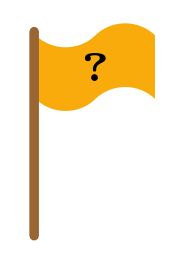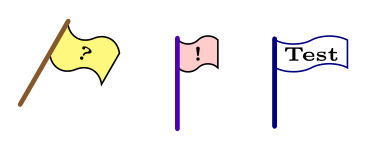|
Hallo! Ich habe hier eine Lösung, unten zitiert, gefunden. Geht das nicht auch irgendwie einfacher? Das Bild zeigt jetzt eine Rechtecksform, denkbar wäre auch ein Dreieck oder sogar ein Doppeldreieck. Danke fürs Lesen und das Interesse!
\documentclass[]{article} \usepackage[ngerman]{babel} \usepackage{tikz} \usepackage{amsmath, amssymb} \setlength{\parindent}{-1.5em} %=========== \begin{document} %=========== \newcommand{\marker}[2]{% name, shift \tikz[overlay,remember picture] {\node (m-#1) at (#2) {};}% } \pgfmathsetmacro{\flagscalefactor}{0.3} \pgfmathsetmacro{\flagrotationdegree}{0} \newcommand{\flagpolecolor}{brown!60!black} \newcommand{\flagcolor}{yellow!67!red} \newcommand{\flagsymbol}{:)} \newcommand{\flagsymbolcolor}{black} \newcommand{\flagadditionalcommands}{} \newcommand{\tikzflag}[1][0,0]{% shift \begin{tikzpicture}[scale=\flagscalefactor, rotate=\flagrotationdegree,shift={(#1)},overlay,remember picture] \draw[fill=\flagpolecolor,thick] (0,0) -- ++ (0,8) arc (180:0:0.4 and 0.1) -- ++ (0,-8) arc (360:180:0.4 and 0.1); \draw[thick] (0,8) arc (180:360:0.4 and 0.1); \draw[fill=\flagcolor,thick] (0.8,7.5) to[out=-30,in=210] ++(3,0) to[out=30,in=150] ++ (3,0) -- ++ (0,-4.5) to [out=150,in=30] ++(-3,0) to[out=210,in=-30] ++(-3,0) -- cycle; \node[\flagsymbolcolor,fill=white,circle,thick,inner sep=1pt, draw,thin] (a) at (3.8,5.25) {\textbf{\flagsymbol}}; \flagadditionalcommands \end{tikzpicture} } \newcommand{\hintflag}[1]{% name \pgfmathsetmacro{\flagscalefactor}{0.1} \pgfmathsetmacro{\flagrotationdegree}{0} \renewcommand{\flagpolecolor}{brown!60!black} \renewcommand{\flagcolor}{blue!50!cyan} \renewcommand{\flagsymbol}{\tiny $!$} \renewcommand{\flagsymbolcolor}{black} \marker{#1}{-1.9,-0.6} \tikzflag[m-#1] } \hintflag{} Der Text Neben der Flagge \\ geht hier weiter. %=========== \end{document} %=========== |
|
Wenn du nur eine einzelne Fahne zeichnen möchtest, dann kannst du auch \documentclass[tikz,margin=5mm]{standalone} \usetikzlibrary{shapes.symbols,calc} \begin{document} \tikz{% \node[ tape,tape bend height=3pt, inner ysep=.1em,inner xsep=.75em, node font=\tiny\bfseries, fill=yellow!67!red ](fahne){?}; \draw[ very thick,line cap=round,brown!80!black ](fahne.north west)--($(fahne.north west)!3!(fahne.south west)$); } \end{document}
Will man mehrere Fahnen einfügen, dann kann man auch ein \documentclass[tikz,margin=5mm]{standalone} \usetikzlibrary{shapes.symbols,calc,quotes,babel} \tikzset{ pics/fahne/.style n args={3}{ code={ \node[ tape,tape bend height=2pt, inner ysep=.1em,inner xsep=.75em, node font=\tiny\bfseries, pic actions, #1 ](-fahne){\tikzpictext}; \draw[very thick,line cap=round,#2](-fahne.north west)--($(-fahne.north west)!#3!(-fahne.south west)$)}; }, } \begin{document} \tikz{ \pic[draw,fill=yellow!50,rotate=-30,transform shape,"?"] {fahne={tape bend height=4pt}{brown!70!black}{2.5}}; \pic[draw,fill=red!20,"!"]at (1,0) {fahne={inner xsep=.5em}{red!30!blue}{.8cm}}; \pic[draw=blue!50!black,"Test",tape bend height=2pt]at (2,0) {fahne={inner xsep=2pt}{}{3}}; } \end{document}
Das geht natürlich auch mit einem Dreieck aus der \documentclass[tikz,margin=5mm]{standalone} \usetikzlibrary{shapes.geometric,calc} \begin{document} \tikz{% \node[ isosceles triangle, inner ysep=.1em,inner xsep=.75em, node font=\tiny\bfseries, fill=yellow!67!red ](fahne){?}; \node[scale=0.65,circle,inner sep=1pt, draw,fill=white!95!black, font=\small\bfseries, ] at (fahne) {?}; \draw[ very thick,line cap=round,brown!80!black ]([yshift=\pgflinewidth]fahne.north west)--($(fahne.north west)!3!(fahne.south west)$); } \end{document} Geht vll. auch für eine "Dreiecksfahne"? :))) Ich habe übr. mal sowas gemacht, damit man da Text in einem Kreis reinschreiben kann:
\begin{tikzpicture}
\node[scale=1.25, tape,tape bend height=3pt,
inner ysep=.1em,inner xsep=.75em,
fill=blue!75!cyan
](fahne){?};
\node[scale=0.65, circle, draw, fill=white!99!black,
%font=\tiny\bfseries,
pos=0.5] at (fahne) {H};
\draw[line width=2.5pt, ,line cap=round,brown!80!black]
(fahne.north west)--($(fahne.north west)!2!(fahne.south west)$);
\end{tikzpicture}
(22 Mai '14, 00:54)
cis
Aja, sehr schön. Irgendwas gab es meiner Erinnerung nach, daß man die Bilder so verzerren konnte, als würde auch die Dreeicksfahne im Wind flattern - ich muß0 mal schauen, ob ich das nochmal finde.
(22 Mai '14, 02:41)
cis
|




Inwiefern soll der Code denn einfacher werden? In seiner jetzigen Form ist er schon ziemlich minimal.
OK. Man weiß ja nie; vielleicht hat jmd. eine gute Idee.